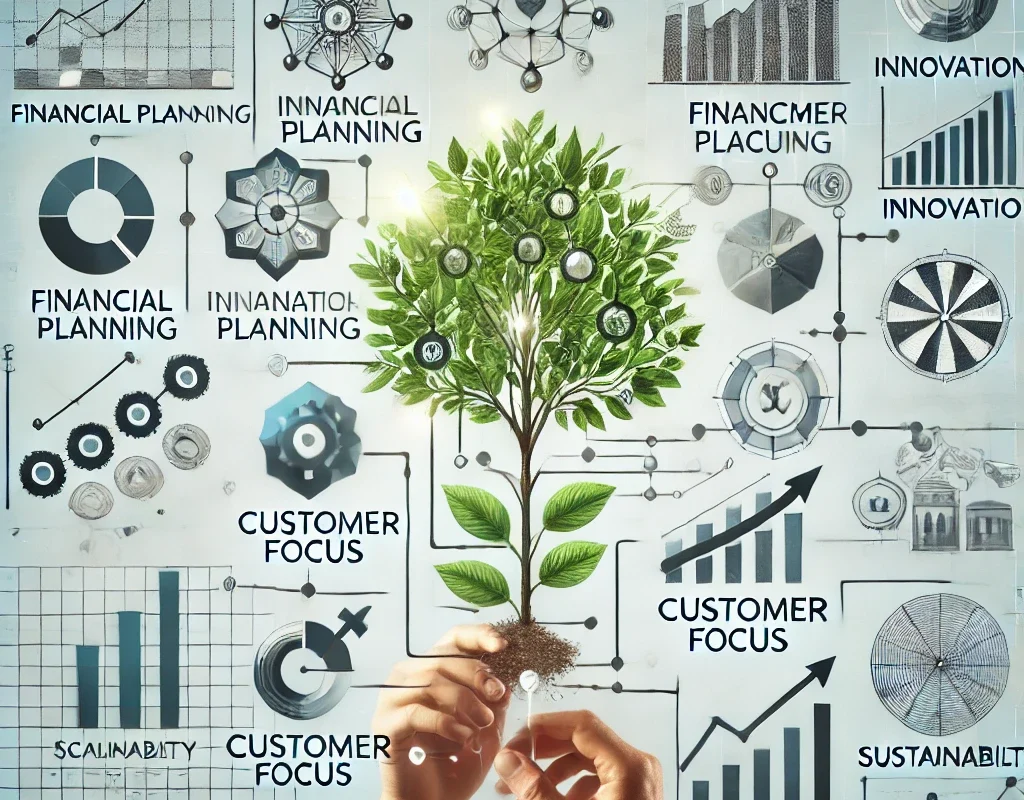A sustainable growth strategy is essential for businesses looking to expand in a way that ensures long-term stability and success. Unlike short-term tactics that can lead to rapid gains but may eventually fizzle out, a sustainable growth approach prioritizes balanced, consistent, and scalable development. Crafting this strategy requires careful planning, foresight, and a deep understanding of both internal and external factors influencing the business.
In this comprehensive guide, we’ll explore how to create a sustainable growth strategy for your business, covering everything from financial planning and market analysis to innovation and corporate social responsibility.
What is a Sustainable Growth Strategy?
A sustainable growth strategy is a blueprint that guides businesses in expanding their operations without overextending resources or compromising future stability. It goes beyond immediate results and focuses on creating long-term value for the company. This type of strategy is designed to be resilient, adaptable to market changes, and scalable, allowing the business to thrive in the long term.
Unlike aggressive growth tactics, which often prioritize speed over substance, sustainable growth emphasizes the importance of thoughtful, calculated decisions. It ensures that businesses can weather economic fluctuations, evolving customer demands, and technological advancements.
Key components of a sustainable growth strategy include comprehensive financial planning, continuous innovation, customer-centric approaches, and a scalable business model.
Benefits of a Sustainable Growth Strategy
Businesses that adopt a sustainable growth strategy reap multiple benefits. First, it reduces risk by focusing on stability over rapid, unchecked expansion. Companies that grow too quickly often face operational inefficiencies, cash flow problems, or market oversaturation. A sustainable approach allows businesses to adapt to market changes without risking their foundational stability.
Secondly, sustainable growth improves brand loyalty and customer retention. A well-planned growth strategy puts customers at the center, offering them consistent value over time. This customer-centric focus ensures long-term relationships that contribute to the company’s success.
Additionally, a sustainable strategy promotes better resource management. It ensures that businesses scale in ways that do not overstretch their workforce, supply chains, or finances, resulting in a healthier, more agile organization.
Assessing Your Current Business Position
Before diving into growth strategies, it’s crucial to assess your business’s current standing. This involves taking a close look at your financial health, operational efficiency, market position, and organizational culture. By understanding where your business currently stands, you can pinpoint areas for improvement and identify potential growth opportunities.
Start by evaluating your financial performance over the past few years. Are there consistent revenue streams, or do you notice seasonal fluctuations? Assessing cash flow, profitability, and debt levels will give you a clearer picture of your financial stability and what you can afford in terms of investment in growth.
Additionally, examine your operations. Are your processes efficient, or do you encounter bottlenecks that slow down production or service delivery? Operational inefficiencies can become a major stumbling block when trying to scale, so addressing them before implementing growth initiatives is critical.
Understanding Market Trends
To grow sustainably, businesses must have a keen understanding of the market they operate in. This involves analyzing industry trends, consumer behavior, and competitor strategies. A clear grasp of these factors will help you identify new opportunities and anticipate potential challenges.
Conducting thorough market research is essential in this stage. Use tools like surveys, focus groups, and industry reports to gain insights into what your target audience wants and how your competitors are positioning themselves. Also, consider using online tools such as Google Trends or SEMrush to track emerging trends and forecast future shifts in demand.
When you have a solid understanding of the market landscape, you can start making informed decisions about where to invest your resources. This could mean expanding your product line, entering new geographical markets, or targeting underserved customer segments.
Identifying Growth Opportunities
Sustainable growth doesn’t just happen—it requires identifying the right opportunities at the right time. One of the first steps in this process is analyzing your current offerings. Are there any gaps in your product or service lineup that could be filled to better meet customer needs? Alternatively, are there complementary products or services that could be developed to enhance your current offerings?
In addition to expanding within your existing market, consider diversification as a growth strategy. This could involve introducing new products or services to different market segments or even entering entirely new industries. For instance, a company that specializes in consumer electronics might expand into smart home technology, leveraging its expertise to tap into a growing market.
By continuously assessing your business environment and staying open to new ideas, you can position your company to capitalize on opportunities that will fuel sustainable growth.
The Role of Innovation in Sustainable Growth
Innovation is a key driver of sustainable growth. Businesses that remain stagnant and fail to innovate often find themselves overtaken by competitors or left behind by changing market conditions. Therefore, embracing innovation is essential for long-term success.
Innovation can take many forms, from developing new products and services to improving internal processes or adopting cutting-edge technologies. The goal is to continuously find ways to improve your business, making it more efficient, adaptable, and customer-friendly.
A good example of innovation’s role in sustainable growth is how many businesses have embraced digital transformation. By adopting new technologies such as cloud computing, artificial intelligence, and automation, companies have streamlined their operations, improved customer experiences, and positioned themselves for long-term success.
Importance of Financial Planning
Financial planning is the backbone of any sustainable growth strategy. Without a clear understanding of your finances, it’s impossible to make informed decisions about where to invest resources, how much to spend on growth initiatives, or when to pull back to maintain stability.
Start by creating a detailed financial forecast that includes projected revenue, expenses, and cash flow for the next several years. This forecast should be based on realistic assumptions and take into account potential risks and uncertainties.
It’s also important to build in some flexibility. As your business grows, unexpected costs or market shifts may arise. Having a financial plan that allows for these contingencies will help ensure that your growth remains sustainable even in the face of challenges.
You can also read; How to Optimize Your Business Strategy for Maximum Profitability
Building a Scalable Business Model
A scalable business model is one that can handle increased demand without compromising efficiency or quality. This is crucial for businesses looking to grow sustainably because it allows them to expand without overburdening their resources.
To build a scalable model, focus on streamlining your operations and improving efficiency. This might involve automating certain processes, outsourcing non-core functions, or investing in technology that can help manage higher volumes of work without requiring significant additional investment.
Another important aspect of scalability is ensuring that your business can grow without overwhelming your workforce. Make sure you have the right infrastructure in place, including training and development programs, to support your employees as they take on new responsibilities and challenges.
In the following sections, we’ll explore customer-centric strategies, the role of leadership in driving sustainable growth, and the importance of corporate social responsibility, among other essential elements of a long-term business strategy.



